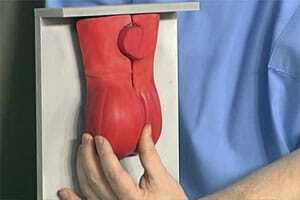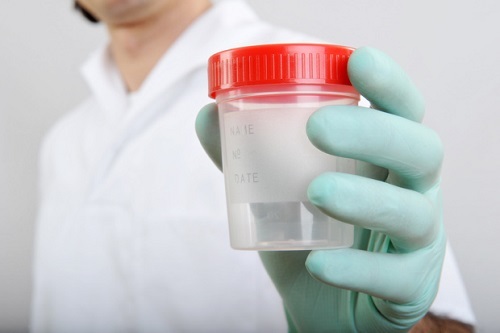There are many diseases that are typical only for males. Usually, such pathologies affect the male sexual sphere and genitals. One of such pathologies is orchitis - an inflammation of testicles in men. Often the inflammatory process is accompanied by lesions of the seed canal( deferentitis) and epididymis( epididymitis).Orchitis is considered a very common scrotal disease, however, it develops primarily as a complication or concomitant pathology, rather than as an independent disease.

Description of orchitis
Orchitis is considered to be inflammatory processes in the tissues of the testicle. If the pathology is bilateral, then the man can become completely infertile, and this condition will be irreversible. Such consequences are caused by the functional significance of the testicles, which are intended for the formation and production of spermatozoa, as well as for the production of androgenic hormonal substances and estrogen.
Thanks to the normal functioning of the testicles, a sufficient amount of testosterone is produced, which is of the utmost importance. This hormone is responsible for libido, secondary sexual characteristics and maturation of spermatozoa, provides an anabolic effect, etc. Therefore, when the testicle becomes inflamed, there is a violation of its functions, which immediately affects the sexual capabilities of the man and his fertility.
Reasons for the appearance of
Urologists identify many causes that explain the development of testicular inflammation:
- Specific infectious processes such as syphilis, gonorrhea, paratyphoid or brucellosis, tuberculosis or typhoid;
- Nonspecific infections caused by the penetration of pathogens of fungal origin( candidiasis, etc.), urogenital infections( mycoplasmosis, chlamydia or ureaplasmosis), viruses( herpes or parotitis, measles or influenza), bacterial pathogens( proteus, staphylococcus, or Pseudomonas aeruginosa.);
- Traumatic factors suggesting a direct impact on the testis tissue. Such an effect is produced during operations or medical diagnostic procedures, with catheterization, etc.;
- Stagnations formed in the blood circulation system or in the seminiferous ducts. There are such stagnation due to hypodynamia, hypothermia, varicose veins. With regard to stagnation in the vas deferens, they are usually provoked by the use of interrupted sexual intercourse as contraception, frequent arousal without subsequent intimacy, abuse of masturbation, prolonged sexual abstinence or excesses in sex.
When infectious origin of orchitis pathogens penetrate into the testicles in various ways: through the blood, urethra, spermatic ways or from the kidneys in the ureter. Sources of the infectious process may be other foci like epididymitis, prostatitis, pneumonia, herpes, urethritis or proctitis, etc. Orchitis often develops against the background of normal hypothermia. In general, the causes of inflammation of the testicles are many, and each requires an individual therapeutic approach.
Clinical picture of
Orchitis is able to flow in two forms: acute or chronic, with each occurring with its manifestations. Acute inflammation usually occurs due to complications of acute infections, and chronic orchitis is formed against a background of chronic inflammatory foci.
Signs of acute orchitis
 Acute inflammation is characterized by the appearance of sharp soreness in the testicle. Often the pain extends to the perineum or waist, groin or sacrum. On the affected half there is a multiple increase in the scrotum. To the touch, it becomes burning, and outwardly acquires a glossy sheen, which is associated with swelling and smoothing of the skin folds. The palpation of the diseased testicle causes severe pain. Since the onset of inflammation, acute orchitis is accompanied by signs of intoxication with a temperature of up to 39 ° C.
Acute inflammation is characterized by the appearance of sharp soreness in the testicle. Often the pain extends to the perineum or waist, groin or sacrum. On the affected half there is a multiple increase in the scrotum. To the touch, it becomes burning, and outwardly acquires a glossy sheen, which is associated with swelling and smoothing of the skin folds. The palpation of the diseased testicle causes severe pain. Since the onset of inflammation, acute orchitis is accompanied by signs of intoxication with a temperature of up to 39 ° C.
Usually, without treatment, signs of inflammation go through a fortnight-month on their own. Sometimes the inflammation progresses, causing an abscess in the tissues of the testicles. As a result of tissue suppuration, the testicles are damaged and reduce the volume of sperm produced, which as a result provokes infertility of a secretory nature.
If orchitis has developed as a result of mumps, its symptoms usually appear on the third day after the development of the underlying pathology or a week after its cure. In 30% of patients, the inflammation is complicated by the bilateral nature of the lesion. In most such cases, the outcome of the disease becomes atrophy of testicular tissues, and, hence, incurable infertility.
Chronic inflammation of the
 Chronic inflammation of the testicles usually develops due to untreated acute orchitis, as well as against chronic urino-genital processes such as urethritis, prostatitis or vesiculitis. For such a pathological form, an erased current with a scarcity of symptoms is characteristic. It happens that the pathology is accompanied by only one symptom - pain when touching the testicle.
Chronic inflammation of the testicles usually develops due to untreated acute orchitis, as well as against chronic urino-genital processes such as urethritis, prostatitis or vesiculitis. For such a pathological form, an erased current with a scarcity of symptoms is characteristic. It happens that the pathology is accompanied by only one symptom - pain when touching the testicle.
If chronic orchitis worsens, tenderness can begin to bother while walking and other movements. This form of orchitis also contributes to the cessation of the secretory activity of testicles, which causes irreversible infertility of men.
Treatment options
The basis of therapy is the elimination of the underlying underlying cause of inflammatory processes. Acute conditions require the patient to be identified in a hospital, because purulent masses accumulate in the testicle. The patient is shown:
- Restriction of motor activity;
- Antibiotic therapy and other medicines prescribed by a doctor;
- Maintenance of the testicles with a special device;
- Applying cold;
- Physiotherapy;
- Surgical intervention.
 The effectiveness of therapy is due to timely and correct diagnosis, as well as an adequate approach to therapy, otherwise the probability of many complications such as infertility or erectile problems is high.
The effectiveness of therapy is due to timely and correct diagnosis, as well as an adequate approach to therapy, otherwise the probability of many complications such as infertility or erectile problems is high.
In case of acute inflammation, in addition to bed rest and cold therapy, Novocain blockades, broad-spectrum antibiotic Cephalosporin, antiseptic preparations like Biseptolum, Gramurin, etc. are prescribed. After normalization of temperature indicators, a course of sessions of electrophoresis, warming compresses or UHF therapy is performed. For the removal of inflammatory processes, NSAIDs like Celebrex, Diclofenac, Ketanov, etc. are used. These drugs relieve pain symptoms and swelling from the affected testicles.
If the inflammation does not respond to therapy, then drugs such as Sulfanilamide or Prednisolone are prescribed. If the orchitis is chronic, then the greatest preference in therapy is given to physiotherapeutic methods of treatment like ultraviolet irradiation, UHF or paraffin applications. For the entire therapeutic period it is recommended to abandon sexual life and wearing tight underwear and clothes, avoid traumatic injuries and hypothermia of the scrotum. When abscessed, surgical treatment is indicated, suggesting removal of purulent masses, removal of affected tissue sites or removal of the testicle.
Than orchitis is dangerous
 Men should be extremely cautious about treating this disease, because self-medication or lack of therapeutic measures is fraught with irreversible consequences. Most patients, unfortunately, often write off the signs of orchitis for colds or chronic prostatic problems. Whereas in their body there are dangerous changes associated with the violation of sperm formation, which subsequently reduces the qualitative indicators of spermatozoa and the probability of fertilization. If the inflammatory process extends to both testicles, then the probability of the onset of male infertility is maximally high.
Men should be extremely cautious about treating this disease, because self-medication or lack of therapeutic measures is fraught with irreversible consequences. Most patients, unfortunately, often write off the signs of orchitis for colds or chronic prostatic problems. Whereas in their body there are dangerous changes associated with the violation of sperm formation, which subsequently reduces the qualitative indicators of spermatozoa and the probability of fertilization. If the inflammatory process extends to both testicles, then the probability of the onset of male infertility is maximally high.
Orchitis leads to inadequate production of testosterone hormones, which provokes changes in body sculpture, a marked decrease in libido, real exchange disorders, and a deterioration in overall well-being. Therefore, if you have any suspicious symptoms, you should immediately contact the urologist, even if you have doubts about the development of orchitis. Swelling of the testicle tissues may indicate the development not only of a relatively safe inflammation, but also of malignant tumor processes. Therefore, a disregard for changes in the scrotum is fraught with dangerous consequences. While timely diagnosis and treatment provide complete relief from the disease.
Prevention
To prevent orchitis is recommended:
- Timely and qualified to treat any inflammatory pathology;
- When infectious pathologies occur, it is absolutely unacceptable to tolerate the disease "on the feet";
- Adhere to preventive measures for STIs;
- Avoid intimate contact with partners who have gynecological pathologies or during menstruation;
- Anal contacts should only be made with a condom;
- Avoid sexual intercourse with women whose sexual health is suspected.
If inflammatory symptoms occur, you can not do self-diagnosis and self-medication. The safest and most effective action will be to contact a specialized specialist. Only such an approach can help in maintaining masculine health.



